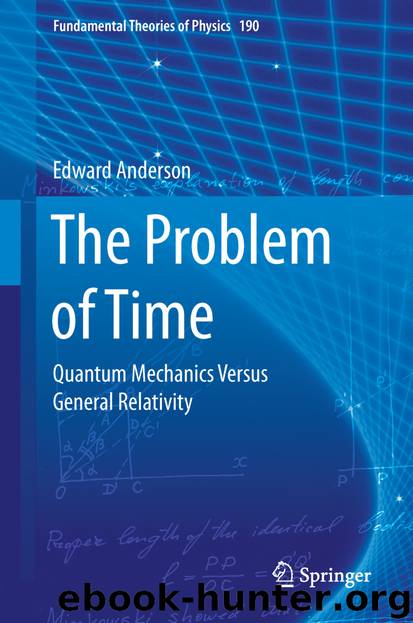The Problem of Time by Edward Anderson

Author:Edward Anderson
Language: eng
Format: epub
Publisher: Springer International Publishing, Cham
Discussion
As a package, the three possible strong ways of evading the obstruction term are the maximum propagation speed , finite and trichotomy. Local Relativity now follows from closure of the constraint algebroid rather than being postulated a priori as it was historically by Einstein. Physical observation of finite maximum propagation speed serves to select GR alone out of the above set of theories.
As an obstruction result, the three types of localized Relativity arise in a similar manner to the much-vaunted critical dimensions 26 and 10 for bosonic strings and superstrings respectively (Sect. 11.8). This is in the sense that all of these are picked out as strong impositions that produce a closed algebraic structure of constraints. Albeit this Chapter’s case involves the classical Poisson brackets closure as a Dirac algebroid (9.31)–(9.33) or the simpler bona fide algebra (24.18), (24.19), (24.23). This is in contrast with String Theory’s quantum commutator closure as a Virasoro algebra or its supersymmetric counterpart ([368, 385, 386] and Appendix V).
Moreover, suppose one adopts the physical choice of locally Lorentzian Relativity. This comes hand in hand with deducing embeddability into a GR spacetime, a formalism and worldview which has long been known to be widely insightful [440, 874].
This Chapter can furthermore be interpreted as an answer to Wheeler’s question (9.1). So the GR form of ℋ arises as one of but a few consistent options upon assuming just the structure of space. This answer to Wheeler’s question ascribes primality to space rather than to spacetime and yet leads to spacetime emerging. Thus it provides a resolution of the classical Spacetime Construction Problem as well, in the sense of construction from space. This result can be considered to arise from local SR, GR and its spacetime structure being rigid, rather than mutable as functioning mathematical structures.
Let us finally compare Einstein’s historical route to GR with the Relational Approach’s. Einstein chose to consider spacetime primality instead of spatial primality. In this setting, he changed the status of frames from SR’s Lorentzian inertial frames to local inertial frames that are freely falling frames. This made direct use of the spacetime connection in passing locally to freely falling frames. Considering the corresponding curvature tensors is now natural, and leads to a law relating the Einstein curvature tensor to the energy–momentum–stress tensor of the matter content. This accounts for the local inertial frames on physical grounds, and the spacetime geometry is to be solved for rather than assumed. However, this approach does not directly address Machian criteria for time and space. On the other hand, in the Relational Approach, the horn in which space is primary is chosen; time and space are conceived of separately, and Leibniz–Mach relational criteria (Chap. 3) are directly applied to each. The notion of space is broadened from that of the traditional absolute versus relational debate arena so as to include geometrodynamical theories. This approach’s equations pick out a particular subcase for which an ambient spacetime manifold is implied; this is a very fruitful perspective as per Chap.
Download
This site does not store any files on its server. We only index and link to content provided by other sites. Please contact the content providers to delete copyright contents if any and email us, we'll remove relevant links or contents immediately.
Tools of Titans by Timothy Ferriss(7800)
Turbulence by E. J. Noyes(7690)
Astrophysics for People in a Hurry by Neil DeGrasse Tyson(4997)
Secrets of Antigravity Propulsion: Tesla, UFOs, and Classified Aerospace Technology by Ph.D. Paul A. Laviolette(4974)
Design of Trajectory Optimization Approach for Space Maneuver Vehicle Skip Entry Problems by Runqi Chai & Al Savvaris & Antonios Tsourdos & Senchun Chai(4837)
Room 212 by Kate Stewart(4729)
Pale Blue Dot by Carl Sagan(4611)
The David Icke Guide to the Global Conspiracy (and how to end it) by David Icke(4376)
A Journey Through Divination and Astronomy by Publishing Pottermore(4245)
Apollo 8 by Jeffrey Kluger(3510)
Goodbye Paradise(3440)
Losing the Nobel Prize by Brian Keating(3424)
COSMOS by Carl Sagan(3346)
The Five People You Meet in Heaven by Mitch Albom(3332)
Brief Answers to the Big Questions by Stephen Hawking(3237)
How to Read Water: Clues and Patterns from Puddles to the Sea (Natural Navigation) by Tristan Gooley(3236)
How to Read Nature by Tristan Gooley(3072)
The Order of Time by Carlo Rovelli(3071)
A Brief History of Time by Stephen Hawking(2819)
